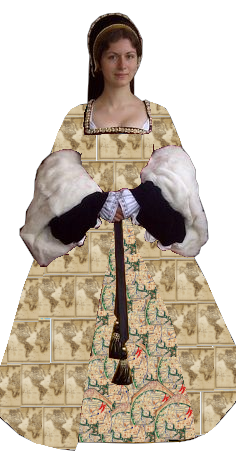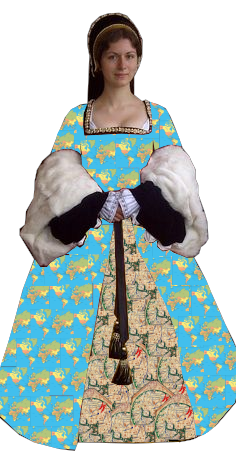A Modern Plague Doctor
- Rio Sambrook

- May 27, 2021
- 5 min read
My final university project was, of course, a costume project. I've wanted to make a historical costume using modern materials since before university (my initial ideas involved a large crinoline and fabric printed with Spiderman comics!), and this was the perfect opportunity to explore that with resources and time.

My initial idea for the project was to create an Elizabethan dress using fabric printed with map patterns, using both modern world maps and the 13th century Hereford Mappa Mundi.
After some playing around with ideas, I eventually settled on creating a costume design based on the iconic plague doctor mask, but with reference to the modern handling of the COVID-19 pandemic instead of the bubonic plague. I also adventured outside of a single historical time period, taking costume inspiration from a variety of eras.

The bubonic plague had major outbreaks in the 14th and 18th centuries, and was a very real threat throughout history. The worst pandemic in European history was "the black death" which swept across Europe in the second half of the 14th century, wiping out a third of the population and changing the course of the development of society. However, the most recognisable symbol of the plague, the beaked plague doctor mask, didn't come into being until the 17th century. My costume design takes particular inspiration from Elizabethan and Georgian ladies fashion, as well as aspects from other parts of history.
All of the historical designs are adjusted to have a focus on the modern handling of the COVID-19 pandemic, with special reference to the way it was handled by the UK government.
The first thing I made was the corset. This pattern for Elizabethan stays comes from The Tudor Tailor by Ninya Mikhaila and Jane Malcolm-Davies, and was the most time-consuming element of the costume! Historically, women wore corsets and stays as support garments, instead of a bra. Elizabethan ladies corsets were often designed to elongate the torso, rather than emphasise the waist or breasts like modern corsets, and the support they provide is much more comfortable to wear long-term.
The most striking part of the costume is the skirt. The French farthingale has a 2 metre diameter, enforcing social distancing. The size of the visual aid was startling for me as I was assembling it, and several audience members commented that it was bigger than they thought it would be for two metres. Of course, despite the skirt on its own being two metres, the wearer is only one metre away from the edge, but as my mother pointed out, if everyone wore them, they would be two metres apart, and I wasn't going to make the skirt 4 metres wide. Even acknowledging that, the scale of the skirt makes it clear what its intentions are.
The farthingale is made from willow, and supported by bamboo canes.

The skirt itself is printed with diagrams, maps and graphs about COVID-19, including information about the spread of the virus, mask safety, and government slogans.
The skirt is made in two pieces: the sides of the skirt are attached to a calico circle which covers the farthingale, and the top of the skirt sits on top. The top piece is supplemented with white cotton panels, giving it a greater circumference, and allowing the fabric to ruffle.
The bodice is made of bubble wrap, forming a protective layer, like the “social bubbles” implemented for slowing the spread of COVID-19.
The bodice pattern is from The Tudor Tailor. It is not boned, but it does have a wooden busk which slots into a channel in the front of the bodice, helping it to keep its shape. The bubble wrap is hand stitched to white linen, and the front layers are hand stitched to the canvas and linen lining. I discovered that sewing machines do not like bubble wrap…
The outer layer is a mantua, a 17th-18th century over-gown or robe. This is made from spunbound-meltblown polypropylene, the same material used to make surgical scrubs. To see more images of the making process, have a look at this post on tumblr and instagram!
The plague doctor mask is also made from polypropylene, but in blue, to look like a disposable mask. The pattern I used was created by tumblr user mctreeleth, and adapted to fit the recognisable pleated appearance. I made a post on the making process on tumblr, which you can read here!

I wanted to draw a parallel between the historical position of the Church and the idolisation of an entity with little to no actual control over the pandemic situation. The recognisable use of the rainbow symbol to show appreciation for the NHS was an easily evocative image, so I used a rainbow “Thank You NHS” pin badge in place of a crucifix in my costume. Instead of praying to a higher power or appealing to the Church for salvation from the bubonic plague, modern UK clapped for the NHS and displayed rainbows to show their appreciation for the under-funded health service. Although these were appreciated by NHS workers, the NHS’s power over the spread of the virus was limited, especially in the crucial early days of the pandemic, due to the Government’s refusal to listen to virology experts, leading to a faster spread of the disease, and more strain to the NHS. Therefore, I think the parallel between prayer to the higher power of God, and appeal to the NHS is bitter, but apt.
The gloves are standard blue rubber gloves, painted with white acrylic to resemble Victorian ladies’ evening gloves. I painted about 20 gloves, so that when they get sweaty they can be easily changed and discarded.

The flower crown is perhaps my favourite part of the costume design, because although it’s not complicated in design or construction, it’s very neat. I chose allium flowers for the crown, because of the medieval medical practise known as “the doctrine of signatures”. This doctrine states that plants resembling parts of the body could be used to treat a disease of that body part. Another example of this is Pulmonaria, or lungwort, so named because of its visual similarity to the lungs.
The allium flower resembles the coronavirus, so I decided to play on this and use it in the costume. In addition to this, edible members of the allium family, such as onions and garlic, have been proven to have anti-viral properties, so there is some truth to this specific case of the doctrine of signatures (although overall the practice is pseudo-science, please do not apply this elsewhere)!
My own outfit for the event wasn’t the focus of the design, but I wanted to have very clear visual links to the main costume. I wore a suit jacket and waistcoat, and made accessories to match. My face mask is made from the same fabric as the skirt, printed with images about COVID-19. My tie is made from the same green polypropylene as the mantua, and my pocket square is bubble wrap.
This project is the most complex design I have ever made, and I have learned loads while making it! Until this, I had never worked with a pattern from a book, this was my first time making a corset or anything that has to be super close fitted, and I worked with a lot of materials I had never used before! I also sourced all the materials myself, and made the majority of the costume in my living room, teaching myself as I went. I am looking forward to continuing to experiment and learn, and can’t wait to find out what I can make next!
.png)



























































Comments